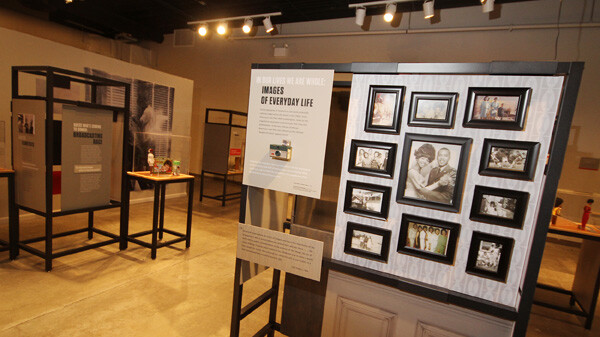Picturing Civil Rights
traveling exhibit features images of historic movement
Amanda Boehm, photos by Andrea Paulseth |

Right now the Chippewa Valley Museum is hosting For All the World to See: Visual Culture and the Struggle for Civil Rights, a nationally touring exhibition from NEH on the Road focusing on the influence of visual media during the civil rights movement, which is a type of exhibit that the museum has never had before. For All the World to See is the first comprehensive museum exhibition to analyze the historic role played by visual images in transforming the fight for civil rights in the United States. This is the first year the show has been traveling, and it will continue to travel for five years. Coincidently, it will be on display at the Chippewa Valley Museum for the 50th anniversary of the Birmingham campaign, an event during which the Birmingham Police Department used high-pressure fire hoses and police dogs to control non-violent protesting in the spring of 1963.
As you enter the Chippewa Valley Museum, there is a statement from exhibition curator Maurice Berger, a senior research scholar at the Center for Art Design and Visual Culture at the University of Maryland-Baltimore County, acknowledging the importance of the camera as the “weapon of choice” for civil rights leaders and activists such as Gordon Parks in the war against racism and segregation.
The exhibition is presented on kiosks, displaying images that range from kid-friendly to graphic. Because there are strong graphic images, the museum took care in placing the images so that visitors would not see them directly. Since these images can still be stumbled upon, the exhibition may not be suitable for children under middle school age.
The attitudes and ideas that are part of this exhibit had to influence people’s thinking throughout the entire United States in order for any change to happen nationwide.
While the exhibition contains mostly two-dimensional pieces such as the covers of Life magazines, advertisements exploiting racial stereotypes, and African-American baseball cards, a variety of three-dimensional artifacts can be seen as well. Among these are buttons, an Aunt Jemima syrup dispenser, and the first mass-marketed African-American doll from 1969.
There is also a projection of moving clips from television shows and performances of black singers and musicians. A hands-on feature of the show is a vintage typewriter that is set up, encouraging visitors to answer the question “What do you think the world needs to see?” and tack their typed responses to a bulletin board for others to read.
In 1955, Emmett Till, a 14 year old from Chicago, was visiting his relatives in Mississippi when he carelessly tried to flirt with a white woman. That evening the woman’s husband and another man dragged Till from where he was staying, beat him to a pulp, and tossed his body into the Tallahatchie River. Mamie Till Bradley, the boy’s mother, demanded that her son’s body be returned to Chicago and put in view of the public. “I couldn’t bear the thought of people being horrified by the sight of my son. But on the other hand, I felt the alternative was even worse. … Let the world see what I’ve seen,” Bradley said. The black press was present at the time that Till’s body arrived in Chicago for the public funeral to take pictures that were printed in Jet magazine. A copy of this issue is in the show inside a clear-topped box that the museum labeled with a graphic imagery warning. Because Till was from Chicago, it became clear that racism affected the entire nation as its devastation crept closer to home. “Everyone in the African-American community knew about it. It affected the older generation and the young because he was a boy that could have been their peer,” says Carrie Ronnander, curator at the museum.
The attitudes and ideas that are part of this exhibit had to influence people’s thinking throughout the entire United States in order for any change to happen nationwide. People in the Chippewa Valley were seeing images through the media that were also seen by people in the South, allowing them to react to what was happening. Some people even traveled to the South to participate in the movement. We live in a nation where the amount of time that slavery has been gone is less than the amount of time that it existed. “That’s why we should have one of these exhibits here – to reflect on the things happening in our environment that we don’t necessarily see,” Ronnander says.
The exhibit For All the World to See: Visual Culture and the Struggle for Civil Rights will be on display at the Chippewa Valley Museum from April 5 to May 26.




















